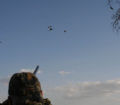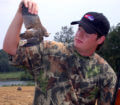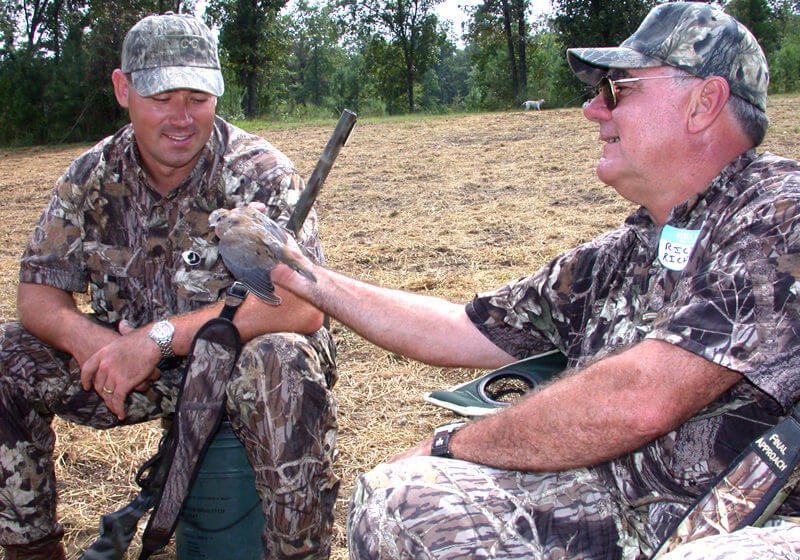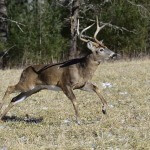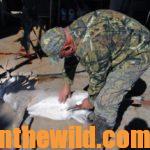Editor’s Note: Jared Mophett of Honey Brake Lodge (www.honeybrake.com) in Jonesville, Louisiana, has been keeping dogs tuned-up and ready for dove season for over 20 years. “I’ve learned plenty from great trainers on how to keep our dogs at Honey Brake in peak performance to retrieve,” Mophett says. Mophett also competes his dogs in the Amateur Division of retrieving dog competitions and in the Super Retriever Series and explains, “I run some dogs in the hunt test. I also have some dogs with professional trainers.” Often, when you’re talking about retrievers, some waterfowlers don’t like to use their duck and goose dogs to pick up doves. But according to Mophett, he tunes up his Labradors before dove season and hunts them during dove season. He believes his dogs are better prepared to find and retrieve waterfowl by his working with them well before dove season arrives. He says you need to expect your dog to perform just as well in the dove field as it does in the duck blind. Remember that you’re training your dog while it’s dove hunting. Let’s look at 10 secrets for getting your retriever prepared for dove season.
 Tip 7: Train Your Retriever to Make Blind Retrieves
Tip 7: Train Your Retriever to Make Blind Retrieves
Spend time with your dog before the season working blind retrieves, which can be critical on a dove shoot when the dog may not be able to see where the bird has fallen. In this scenario, the dog has to depend on its hunter to point it in the direction that the bird has fallen and steer the dog to the right spot where it can use its nose and eyes to find the bird that it hasn’t seen fall. The dog has to be trained to make blind retrieves. If the dog’s not well-trained before dove season starts, let the dog practice its blind-retrieve skills before you call on it to go and try to find a dove that it hasn’t seen fall. Remember we’re not talking about tuning-up a dog that’s already trained to be prepared to hunt and make retrieves in a dove field. You have to give the dog a cue to let it know that it will find a bird that it hasn’t seen fall.
The dog should be sitting at your side. You should stand up and tell the dog, “Dead bird.” If the dog has been trained, it understands what those words mean. The dog knows that you’re asking it to search for a dove it hasn’t seen fall and understands that you’ll direct it to the spot where you want the dog to look for that bird. The dog knows that the hunter will send it out in a straight line where the hunter wants it to locate the bird. If the dog overruns or misses the spot, the hunter then can direct the dog to where he wants the dog to search for the bird. If the dog fails to find the bird, and the dog hears a whistle, it knows to turn and look at the hunter and get directions to the spot the hunter wants it to hunt next.
Tip 8: Train Your Dog Not to Bite, Chew or Eat the Dove It’s Retrieving
 One of the problems that hunters may have – more so with doves than with ducks – is that the dog bites or chews the dove it’s supposed to be retrieving. Most dogs are trained through force fetching to be soft-mouthed, which means they pick up the birds and carry them in their mouths to their hunters, without biting, chewing or trying to eat the birds. So, if you don’t work with a dog before dove season arrives on carrying the bird in its mouth, rather than biting or chewing the bird, once the dog picks the bird up, brings it to the hunter and places it in the hunter’s hand, you may have a problem. The best way to solve this problem is with a sharp, firm, “No.” Nothing makes a retriever dog happier than pleasing its hunter and being praised by its hunter. Nothing shames a dog more than a hard, firm, “No,” that carries the connotation of, “You did wrong. Don’t do this again.” A trained dog has been trained to hold that bird in its mouth, until the hunter gently takes the bird out of the dog’s mouth. If the dog doesn’t respond positively to a hard, “No,” the next time the dog bites or chews a bird, tap the dog under the chin, which is the form of correction that a trainer usually uses in teaching the dog to hold the bird gently in its mouth.
One of the problems that hunters may have – more so with doves than with ducks – is that the dog bites or chews the dove it’s supposed to be retrieving. Most dogs are trained through force fetching to be soft-mouthed, which means they pick up the birds and carry them in their mouths to their hunters, without biting, chewing or trying to eat the birds. So, if you don’t work with a dog before dove season arrives on carrying the bird in its mouth, rather than biting or chewing the bird, once the dog picks the bird up, brings it to the hunter and places it in the hunter’s hand, you may have a problem. The best way to solve this problem is with a sharp, firm, “No.” Nothing makes a retriever dog happier than pleasing its hunter and being praised by its hunter. Nothing shames a dog more than a hard, firm, “No,” that carries the connotation of, “You did wrong. Don’t do this again.” A trained dog has been trained to hold that bird in its mouth, until the hunter gently takes the bird out of the dog’s mouth. If the dog doesn’t respond positively to a hard, “No,” the next time the dog bites or chews a bird, tap the dog under the chin, which is the form of correction that a trainer usually uses in teaching the dog to hold the bird gently in its mouth.
To contact Mophett at Honeybrake, call 318-775-1007.
To learn more about hunting, check out John E. Phillips’ print, Kindle and Nook eBooks and audiobooks at johninthewild.com/books.

